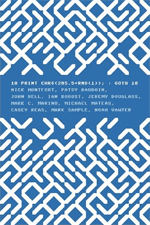 My next book is even stranger than my last. It’s an entire book, 65,000+ words worth, about a single-line Commodore 64 BASIC program that is inscribed in the book’s title, 10 PRINT CHR$(205.5+RND(1)); : GOTO 10. And if that isn’t strange enough, I wrote the book with nine other collaborators (Nick Montfort, Patsy Baudoin, John Bell, Jeremy Douglass, Mark C. Marino, Michael Mateas, Casey Reas, Mark Sample, Noah Vawter) in a single voice. It’s not an edited collection—it’s one flowing discussion written by ten people. About a one-line C64 BASIC program.
My next book is even stranger than my last. It’s an entire book, 65,000+ words worth, about a single-line Commodore 64 BASIC program that is inscribed in the book’s title, 10 PRINT CHR$(205.5+RND(1)); : GOTO 10. And if that isn’t strange enough, I wrote the book with nine other collaborators (Nick Montfort, Patsy Baudoin, John Bell, Jeremy Douglass, Mark C. Marino, Michael Mateas, Casey Reas, Mark Sample, Noah Vawter) in a single voice. It’s not an edited collection—it’s one flowing discussion written by ten people. About a one-line C64 BASIC program.
Despite it’s relatively simple form and structure, the program produces a surprisingly intricate maze pattern using the C64’s unique PETSCII graphical characters. The book discusses many aspects of this feat from different perspectives, including the history of mazes, porting, randomness, the BASIC language, and the Commodore 64 platform. It’s interspersed with short “remarks” (get it, BASIC dorks?), among them discussions of assembly, the demoscene, and a variety of ports, including one I somehow wrote to run on the Atari 2600.
The book is also be beautifully designed by one of the authors, Casey Reas, and printed in two colors with halftoned images and full-bleed layouts so as to get the “Commodore blue” into the pages. The book will be published in the MIT Press’s Software Studies series, a sister venue to Nick and my Platform Studies series. We’re all very grateful to the MIT Press and our editor Doug Sery for taking on such a bizarre project—and particularly for allowing it to be written, designed, and completed on our strange terms.
The official blurb about the book appears below. You can pre-order it now; it will reach your doorstep mid-fall 2012.
This book takes a single line of code—the extremely concise BASIC program for the Commodore 64 inscribed in the title–and uses it aa a lens through which to consider the phenomenon of creative computing and the way computer programs exist in culture. The authors of this collaboratively written book treat code not as merely functional but as a text—in the case of 10 PRINT, a text that appeared in many different printed sources—that yields a story about its making, its purpose, its assumptions, and more. They consider randomness and regularity in computing and art, the maze in culture, the popular BASIC programming language, and the highly influential Commodore 64 computer.